-
-
January 10, 2022 at 8:16 pm
msoffa
SubscriberI am a relatively new ANSYS user trying to find my way after years of using NASTRAN with PATRAN & FEMAP. I have found that some problems I want to solve are far more intuitive and powerful in ANSYS but some things remain very frustrating. I am hoping someone can help me to understand this one!
I am using ANSYS 2021R1. In Workbench I have a modestly sized shell element model (~65K nodes and elements) that I am running a base acceleration analysis on with the intent of developing base drive transfer functions to a small number of nodes. To do this I have a Modal system feeding three Harmonic Response systems. The Modal system has the structure in question grounded at its base. Each of the Harmonic Response systems has a 0-300Hz 1g acceleration load applied as a base excitation applied in either the X, Y, or Z axes. I am using the modal superposition technique. The structure in question has about 50 modes in the analysis frequency range.
Everything works just fine and I can get the answers that I want. The issue that I have is that the MSUP expansion pass ("Expanding Harmonic Solution") step takes A LONG TIME. The modal solution and harmonic solution take maybe 10 minutes; the harmonic expansion pass takes ~3 hours (depending on the # of frequency points etc.) This really surprises me because I am only recovering displacement results - so what is ANSYS doing for all that time? My NASTRAN experience tells me that somehow I should be able to get the solver to spit out what I want in far less time.
I have tried a few things to speed things up with no significant change in compute time:
1.) I have turned off all of the un-needed output requests (all of them, in fact...) in the harmonic solution.
2.) I have tried reducing the number of results stored in the .rst file using OUTRES commands in a APDL command snippet.
3.) Just to mention it, "Skip Expansion" does not work because of the base excitation input.
I'm wondering if the last point is really the issue - does ANSYS need to do a larger expansion to apply the base excitation? Can I get around this by applying the base excitation another way; i.e. large mass method?
I'm sure my not understanding this problem has to do with the script-like execution of ANSYS vs. the deck/batch-like execution of NASTRAN. Can anyone offer any insight / tips to speed up my solve? I can of course provide more details if necessary.
January 11, 2022 at 2:55 amaisin_3
SubscriberI have the same problem and hope to find an answer.
January 11, 2022 at 7:37 amBenjaminStarling
SubscriberWhat do you mean by base excitation? Is this being applied as an inertial load to all elements? I don't understand why the skip expansion option is not available to you?
Base excitation (as I typically would use the term) means applying displacements, velocities or accelerations to the constrained nodes of your model, and this isn't possible in a harmonic response analysis (as far as I am aware).
You are correct that the expansion pass is very slow, and regardless of what results you request, seems to take the same amount of time. But the expansion pass is only required for derived results such as element strains/stresses, and forces.
If you are able to attach your model please do, otherwise some screenshots showing the model, loading, and analysis settings should suffice (or command inputs if you are using MAPDL)
January 11, 2022 at 12:36 pmmsoffa
SubscriberI mean base excitation as in an acceleration being applied to all nodes including the constrained nodes of the model. It is available as an option in Workbench for acceleration loads:
 I don't know if that's a newer ANSYS feature or not and I don't necessarily understand how it translates to the APDL world.
I don't know if that's a newer ANSYS feature or not and I don't necessarily understand how it translates to the APDL world.
I didn't state this explicitly before but the outputs I am looking for are displacements. My model looks like this:
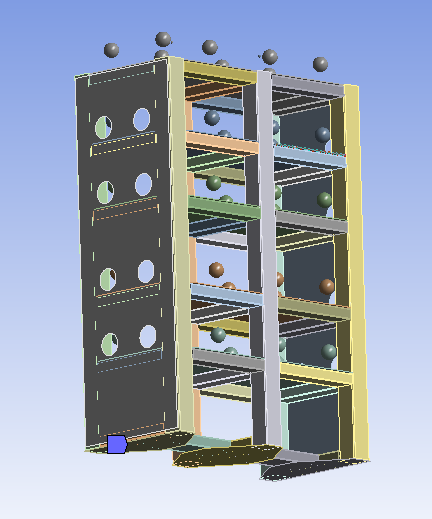
It is essentially a bunch of point masses connected to a shelf. The shelf is meshed with shell elements. There are about 65K elements and nodes. It is constrained at the bottom surface (3 faces, shown above.) I have a Modal system connected to a Harmonic Response system. The analysis settings for the Modal system are as follows:
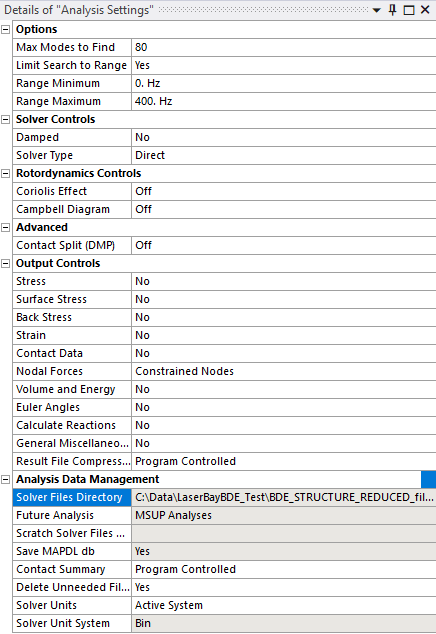 I was a little off in my estimate earlier, going from memory: 80 modes gets me results to ~ 350Hz. The linked harmonic analysis system has the following analysis settings:
I was a little off in my estimate earlier, going from memory: 80 modes gets me results to ~ 350Hz. The linked harmonic analysis system has the following analysis settings:
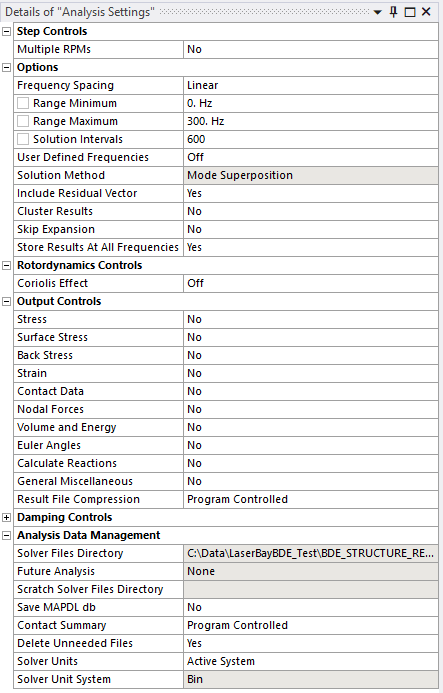 The acceleration load is applied as shown above. (Before someone mentions it, the linear frequency spacing is necessary for my external post-processing...) If I switch "Skip Expansion" to "Yes", I get an error saying that you can't skip expansion with base excitation. I am making a guess that the implementation of base excitation requires the expansion pass? Otherwise this would be ideal. Can anyone explain why the limitation on base excitation exists? I have not tried doing the large mass method for base excitation but I am wondering if that's a possible workaround.
The acceleration load is applied as shown above. (Before someone mentions it, the linear frequency spacing is necessary for my external post-processing...) If I switch "Skip Expansion" to "Yes", I get an error saying that you can't skip expansion with base excitation. I am making a guess that the implementation of base excitation requires the expansion pass? Otherwise this would be ideal. Can anyone explain why the limitation on base excitation exists? I have not tried doing the large mass method for base excitation but I am wondering if that's a possible workaround.
As I said earlier, I tried turning off the output requests as you can see above as I am only interested in the displacement solution. That did not seem to change much. I also tried limiting the scope of the output using OUTRES in a command statement. That reduced the results file size but not really the run time.
Thanks for your responses!
January 11, 2022 at 12:53 pmBenjaminStarling
SubscriberWhat version of Ansys are you using? Are you possibly using an ACT extension? I am using 2021 R2 and what you have shown for the acceleration load looks completely different to what I am used to been using since 18.2 (~2017).
The acceleration load object does not have a Scope->Boundary Condition option, unless you are using Response Spectrum Analysis, but then the details windows looks different again. The Acceleration load details window looks as I have attached below, with "All Bodies" greyed out, as Mechanical is yet to support component applied acceleration loads (even though APDL has supported this forever).
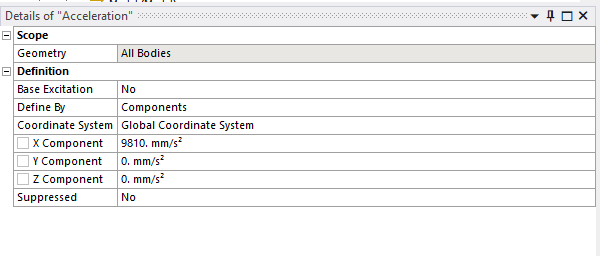 January 11, 2022 at 1:04 pm
January 11, 2022 at 1:04 pmmsoffa
SubscriberI am using 2021 R1. I think if you were to change "Base Excitation = Yes" your dialog box would look like mine.
January 11, 2022 at 1:18 pmBenjaminStarling
SubscriberWow thatÔÇÖs an oversight on my part. Although in my defence, the forms in Ansys are typically pretty good and flow top down, didnÔÇÖt expect that option to actually change what can be scoped.
I will be able to take a look at the ds.dat tomorrow and see if we can find a work around. My understanding is that you should be able to skip the expansion, as this method shouldnÔÇÖt require any derived results, so the limitation would entirely be to do with the implementation in mechanical. But base excitation in harmonic response is new to me, so my understanding of the theory is probably poor in this case.
January 11, 2022 at 1:41 pmmsoffa
SubscriberThanks again for your help! I have taken a few spins through the ds.dat but I have a ways to go with my APDL understanding. I have wondered if I would have an easier time doing this efficiently in APDL but have not taken that step.
January 11, 2022 at 11:58 pmBenjaminStarling
SubscriberSo the issue appears to be with the "Absolute Result" setting, which literally appears to be THE option to trigger enforced motion, which is odd and a bit confusing. It does appear to be an issue with the implementation in Mechanical. I am not familiar with your project, but if solving without enforced motion is acceptable, then this could be an option. Not sure if base excitation without the enforced motion part of it yields the same results.
To skip expansion.
In the ds.dat of the harmonic response, remove everything following the second solve command. Everything after this is for expansion.
Take all the files from the modal solution (except the modal ds.dat), and your edited harmonic response ds.dat, and copy them to a new folder.
Run MAPDL either in batch or GUI, ensuring SMP/DMP and number of cores are the same as the original modal solve, and solve ("read input from" when in GUI) the ds.dat.
This will generate a .rst file with only displacement results.
Unfortunately this result file does not open in Mechanical, and I am not sure why. The result file can be opened and post processed in MAPDL. I have attached a screenshot showing the enforced motion being visible in the results, the original fixed location of my beam was at the origin. For my test model, solution is in seconds, and the expansion pass is many minutes, so a considerable time save.
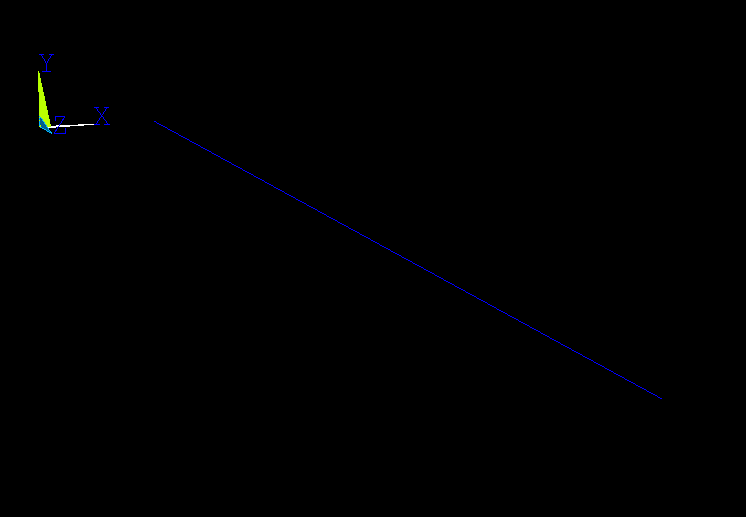
January 12, 2022 at 12:13 amBenjaminStarling
Subscriber***this actually may not be correct. not sure what I am missing, but the result file just appears to be modes, with the final mode shape just being a rigid body mode. This appears to be created after the first solve command. The second solve command does not seem to add results to the rst file or change the rst file.
January 12, 2022 at 12:27 amBenjaminStarling
Subscriber***** a much better solution
add a command snippet to the Harmonic response
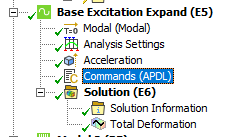 insert command numexp,all,,,no
insert command numexp,all,,,no
 In the details window, set "Step Selection Mode" to "Harmonic Expansion"
In the details window, set "Step Selection Mode" to "Harmonic Expansion"
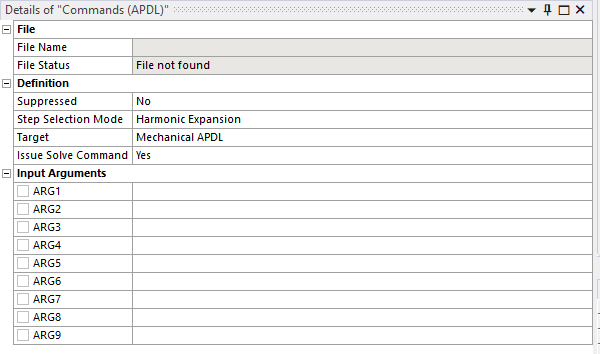 solution shows enforced motion. and takes only seconds to solve and write result file.
solution shows enforced motion. and takes only seconds to solve and write result file.
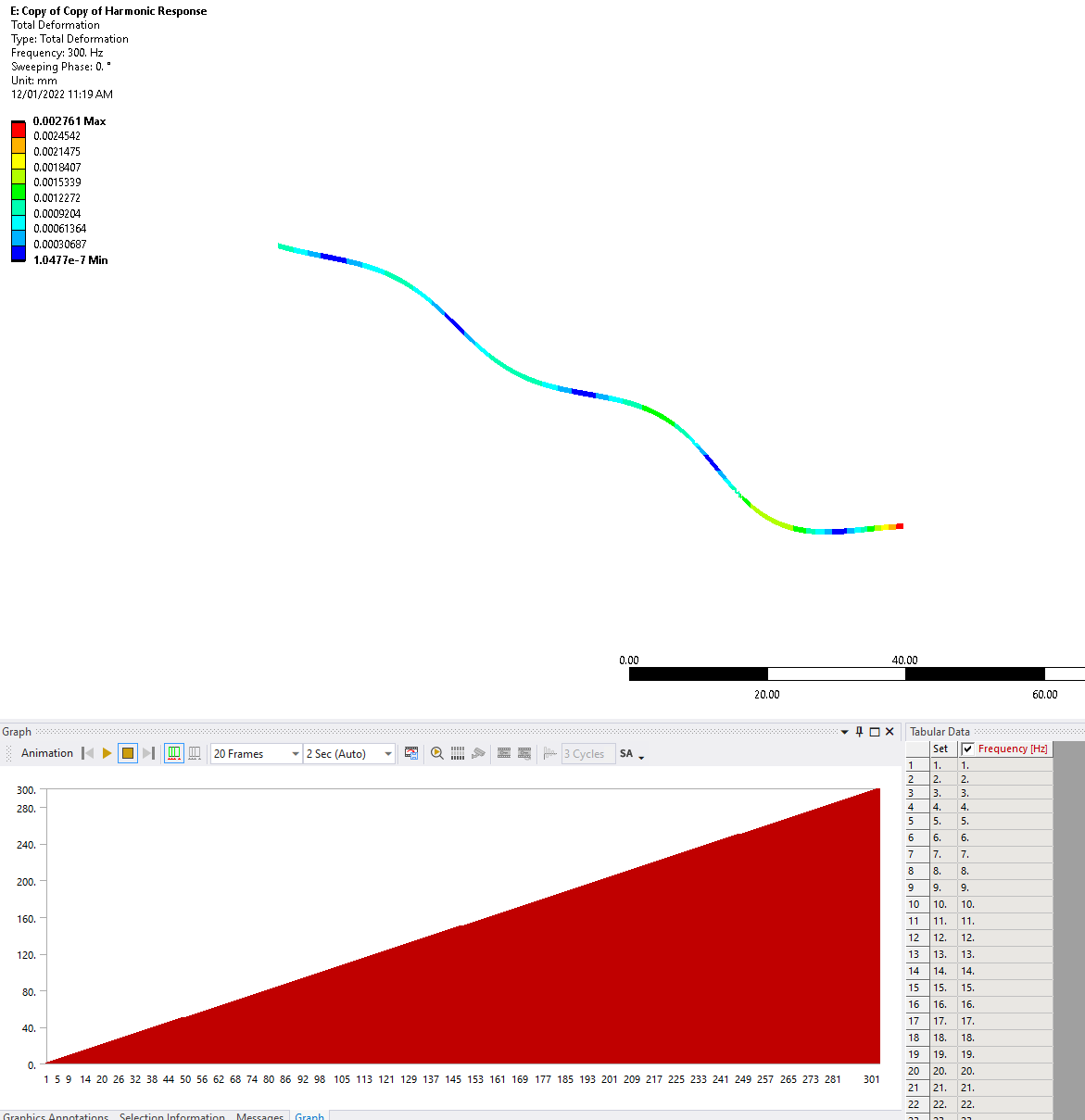
this doesn't technically skip the expansion pass, but tells the expansion pass not to calculate any additional results, so kind of the same thing
January 12, 2022 at 11:53 ammsoffa
SubscriberExcellent work!!! I will give this a try in my model and see how it works.
January 12, 2022 at 6:13 pmmsoffa
SubscriberI confirmed that this works in my model. Solve time goes from 6 hours to 10 minutes.
Thanks again!
January 13, 2022 at 8:33 amBenjaminStarling
SubscriberQuite a few enhancements to MSUP and linear dynamics in the next release, one specifically adressing this issue.
[Image was removed due to copyright]
January 13, 2022 at 8:55 amErKo
Ansys Employee
Many thanks for looking into this and helping out in the forum - please though, refrain from posting Ansys slides like the one in the previous post (it has been removed due to confidentiality and copyright/not allowed to be distributed).
Thank you
Erik
January 13, 2022 at 8:57 amBenjaminStarling
SubscriberThis is available on the customer portal, so likely anyone visiting this forum can access this information?
I would like to be able to share this information as I think it is valuable to people in this forum, whether they can access it directly or not, so just a couple more points to hopefully be able keep this information available on the forum.
These slides often get taken by resellers and ansys channel partners and posted on youtube or in webinars
The same confidentiality statement applies at the bottom of every help page, but I have often screenshot these pages and posted in this forum without them being removed
The information in these slides essentially becomes the "whats new" page in Mechanical, which is available to all users of the software.
January 13, 2022 at 9:56 amErKo
Ansys EmployeeHi
Yes many times they have not been seen and hence not been removed. It is not always possible to spot every one.
But what we can say in general (and this forum) and the rule is do not post any material that are Ansys related (or from any other sources which are not one's own, since they can be copyright issues and other technicalities that does not allow one to distribute material that is not their own). So by not posting screenshots (Ansys related material) avoids any infringements and legal issues, so something to have in mind when we post material that is proprietary and not our own - just refer to a section the help manual (if it is about help), if it is a an Ansys course, refer to that course, etc.
This is also stated in our rules and guidelines (last post - but we will expand that perhaps to include any Ansys material, not only product documentation).
In general for reference,
Screenshots are generally covered by copyrightand should be used with the permission of the copyright holder.
Erik
Viewing 16 reply threads- The topic ‘ANSYS Workbench Harmonic Response Expansion Pass’ is closed to new replies.
Innovation SpaceTrending discussionsTop Contributors-
4663
-
1545
-
1386
-
1230
-
1021
Top Rated Tags© 2025 Copyright ANSYS, Inc. All rights reserved.
Ansys does not support the usage of unauthorized Ansys software. Please visit www.ansys.com to obtain an official distribution.
-


Ansys Assistant

Welcome to Ansys Assistant!
An AI-based virtual assistant for active Ansys Academic Customers. Please login using your university issued email address.
Hey there, you are quite inquisitive! You have hit your hourly question limit. Please retry after '10' minutes. For questions, please reach out to ansyslearn@ansys.com.
RETRY







